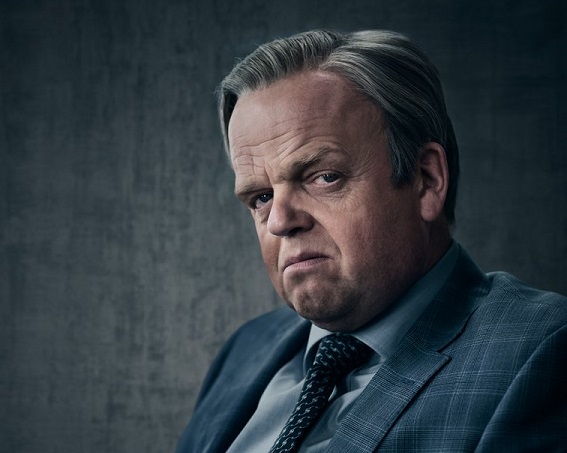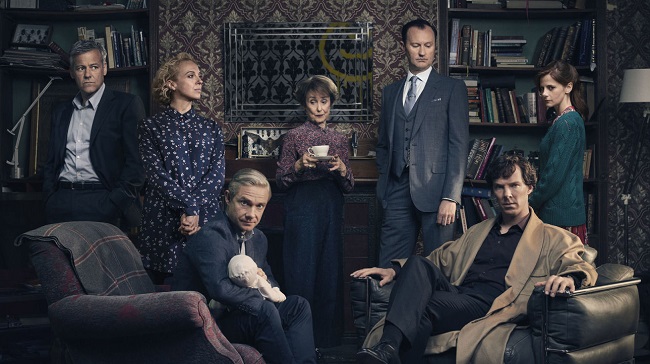Another week of Sherlock, another heart-in-your-throat ending. This time a cliffhanger, even. We’ll get to that below, in the spoiler section, but you should probably go ahead and watch this episode.
(You can do it right now at pbs.org, even. Go ahead, tell your boss I said it was fine.)
Sunday night’s episode, “The Lying Detective,” picked up some time after the events depicted in “The Six Thatchers,” last week’s season premiere. (Spoilers to follow for that episode, if you haven’t seen it yet. It’s impossible not to. I’m sorry. If you have to stop now, I understand, and I wish you luck.)
In the wake of Mary’s death, John is in therapy. Which doesn’t seem to be helping, at least not at first, since he’s still seeing Mary. And talking to her. Which plays nicely against Sherlock’s own coping method: using heroin.
It’s been a while since he was off the wagon. Season 3’s finale opened with a doped-up Sherlock, but that was revealed to be all part of a plan to portray false weaknesses in the face of blackmailer Charles Magnussen. That reveal was early on.
“The Lying Detective” offers no such reprieve, at least not right away. And Sherlock is very much using, that is clear. This means the early parts of the episode play a bit more like Trainspotting, an interesting choice for Sherlock. It also means we have two unreliable narrators in the two leads.
And then we meet Culverton Smith, played by Toby Jones. (Who is not Timothy Spall, if that helps.) Smith comes across as a sort of Donald Trump-alike, a wealthy businessman and reality television star who might be hiding a much darker secret. Indeed, his storyline also plays upon the idea of muddled memory and unreliable narration, as he “confesses” to a group of confidantes who are under the influence of a mind-altering drug.
Which again brings elements of a far trippier show into play. This week’s Sherlock is indeed more experimental along those lines, though in general it does feel a bit more cinematic in its approach than “The Six Thatchers,” which at times dove too far into the TV movie realm via framing devices and visual transitions. It’s a welcome change, even if the hallucinatory passages fall a bit short.
They’re in service of the narrative, though, and it’s a pretty good one. Sherlock is visited by Smith’s daughter, who says her father is a killer, but the drugs she was forced to take have ruined her ability to recall any crucial details. She and Sherlock venture out for a night’s stroll, an event treated as a matter of national security by Mycroft. And then, after an evening, she vanishes. Between the surveillance pointedly not glimpsing a companion and Sherlock’s drug habit, we’re left to wonder if she’d ever been there at all.
Sherlock’s gambit appears to be similar to his efforts in season 3, as Culverton Smith essentially owns a hospital, to which Sherlock gets himself admitted due to his substance abuse. But he’s gone quite far with it, and though he’s revealed to have been orchestrating most of the machinations we see, he still ends up in a very precarious position. Meanwhile, John continues to discuss his issues with mental Mary, who points out a few instances where Mycroft isn’t wholly truthful, including a slip of the tongue that could reveal a lost Holmes brother.
(Some spoilers to follow.)
Smith ends up being as much H.H. Holmes (the real-life serial killer of Devil in the White City fame, who might soon be portrayed by Leonardo DiCaprio) as Donald Trump, and it’s an inspired bit of lore to bring into a Sherlock Holmes tale. At some point, though, after Sherlock appears to make a mistake, he ends up alone and vulnerable in a hospital bed, with Smith trying to kill him.
And then John and Mrs. Hudson discover the DVD Mary left for Sherlock. It turns out Mary left detailed instructions for Sherlock to place himself into as much danger as possible to force John to save him, and in the process save himself. It’s a bit over-plotted, to be honest, but we do learn that Sherlock was in control the entire time.
MAJOR SPOILERS FOLLOW
Except… maybe not? As it turns out, the woman who visited Sherlock wasn’t Smith’s daughter. That’s brushed away, as Sherlock assumes he’d imagined or hallucinated her. But no, she was very much real. Because she’s the same woman who John’s seeing for therapy. And she’s the same woman John met on the bus, with whom he almost cheated on Mary.
Members of the Holmes family tend to be masters of disguise, after all. And indeed, the long-lost brother hinted at earlier in this episode (and in a seemingly throwaway line in season 3) is, in fact, a sister.
Not only that, but an apparently evil one, who might indeed be behind the “Miss me?” message bearing Moriarty’s visage. The main clue? Her name: Eurus. The East wind, which we also learned in the season 3 finale was how Mycroft would describe an oncoming evil. Sherlock, though, never made that connection. Perhaps because he didn’t know his sister’s actual name?
Remember, there have been multiple hints dropped about Sherinford this season. Could that have been Mycroft’s code name for their sister, one Sherlock never knew? Could he have been lying to Sherlock for all these years? And is Eurus somehow tied in with Moriarty? An evil Holmes would be quite an opponent, indeed.
More pressingly, the episode ends with Eurus firing a gun at John, so that’s probably going to have to be solved first.
Verdict: Good Television
[You can read all of The Comeback’s coverage of Sherlock here.]


